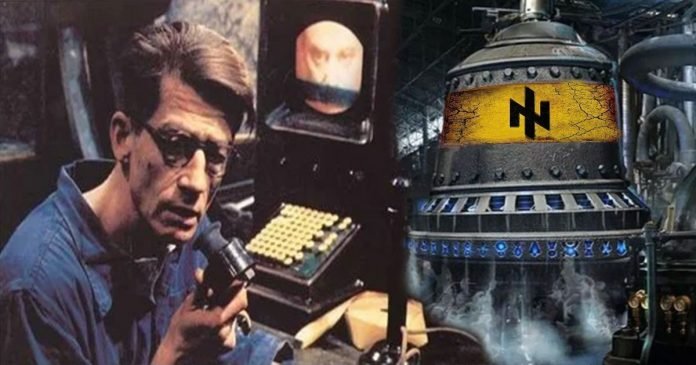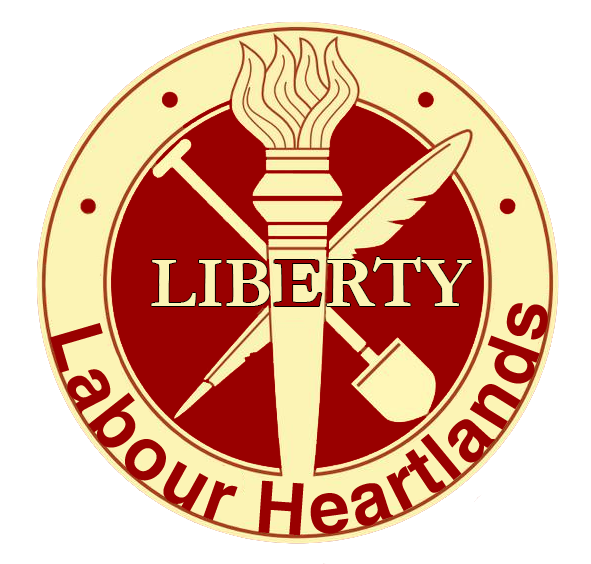When it comes to Ukraine there seems to be some sort of ‘Collective Amnesia,’ everything has gone down the memory hole.
Warning this weeks-long read…
The memory hole… The concept was first popularized by George Orwell in his 1949 dystopian novel Nineteen Eighty-Four.
The main protagonist Winston Smith worked for the Ministry of Truth, his job required him to get rid of anything that ran afoul of state propaganda, he states: “When one knew that any document was due for destruction, or even when one saw a scrap of waste paper lying about, it was an automatic action to lift the flap of the nearest memory hole and drop it in”.
Afterwards, the state systematically re-created all potentially embarrassing historical documents, in effect, re-writing all of history to match the often-changing state propaganda. These changes were complete and undetectable.
Today’s definition of Orwell’s memory hole is any mechanism for the deliberate alteration or disappearance of inconvenient or embarrassing documents, photographs, transcripts or other records, such as from a website or other archive, particularly as part of an attempt to give the impression that something never happened.
There is an attempt to ‘memory-hole’ the last eight years of Ukraine’s history, however, technology is not quite there yet and any half-decent Blogger can retrieve data even that which has been sent down that proverbial hole.
It also has to be clearly stated that my article in no way and, without virtue signalling, undermines or distracts away from the very real struggles Ukrainian refugees are undergoing.
The Ukrainian people like all workers and refugees around the world are not responsible for the political decisions of their leaders. Governments and politicians are voted to office on their promises, those promises seldom reflect the realities, it is always they that break the covenant of trust, betraying their manifestos as if promises don’t matter.
I have every sympathy for the people of Ukraine and they should be supported in every humanitarian way. They deserve better, they deserve their freedom and the right to self-determination without Russian and Western influence, an influence that has created this entire situation.
It’s also noteworthy to say, we all have a job to hold our politicians to account. around the world, anti-war protests are growing including in Russia our power is in protest and the ballot. This war and those that have brought it about should be condemned to the fullest.
Proxy wars.
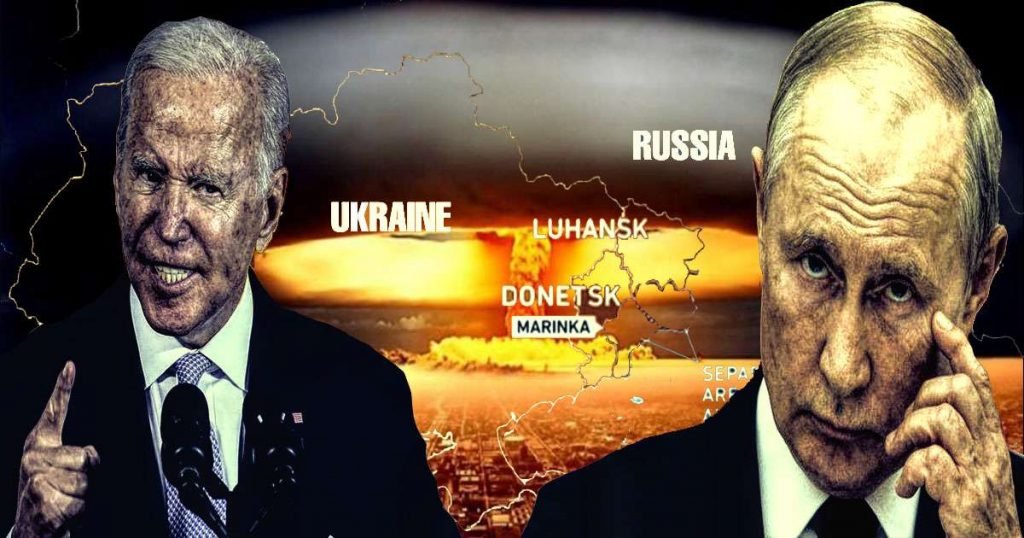
The Russian invasion of Ukraine is a violation of the UN Charter. Without UN authorization, states are allowed to use armed force only in cases of self-defence or to prevent an imminent attack.
Russia will no doubt rely on the same excuse of protection and peacekeeping in Donbas, that NATO’s “pro-interventionists” used for their own military intervention during the Kosovo War. There will be attempts to justify its inception, suggesting it was conducted on the premise of a ‘just cause’: the prevention of mass slaughter and ethnic cleansing against the pro-Russian peoples of Donbas.
Although the US has used Ukraine as a proxy in its fight against Russian-backed Ukrainian rebels in the Donbas, that conflict is still within Ukraine’s sovereign borders.
Even if a case could be made that Russia has the right to defend besieged ethnic Russians, that argument is undercut by Russia’s decision to attack far deeper into Ukrainian territory. If defending the Donbas was Russia’s aim, then it could have pushed harder for an international peacekeeping force, or any number of non-military, diplomatic options.
Ukraine and the US dangling NATO membership over an already volatile situation knowing full well it would result in an esculation of one sort or another.
It’s ironic. during the Cuban Missile Crisis, leaders of the U.S. and the Soviet Union engaged in a tense, 13-day political and military standoff in October 1962 over the installation of nuclear-armed Soviet missiles on Cuba, just 90 miles from U.S. shores. The Americans would not tolerate the Russians in their backyard, yet tongue in cheek they pursued a Ukraine NATO membership.
Bernie Sanders stated…
“I know it is not very popular in Washington to consider the perspectives of our adversaries, but I think it is important in formulating good policy”.
I think it is helpful to consider this: One of the precipitating factors of this crisis, at least from Russia’s perspective, is the prospect of an enhanced security relationship between Ukraine and the United States and Western Europe, including what Russia sees as the threat of Ukraine joining the North Atlantic Treaty Alliance (NATO), a military alliance originally created in 1949 to confront the Soviet Union.
It is good to know some history. When Ukraine became independent after the Soviet Union collapsed in 1991, Russian leaders made clear their concerns about the prospect of former Soviet states becoming part of NATO and positioning hostile military forces along Russia’s border. U.S. officials recognized these concerns as legitimate at the time.
One of those officials was William Perry, who served as Defense Secretary under President Bill Clinton. In a 2017 interview, Perry said and I quote, “In the last few years, most of the blame can be pointed at the actions that Putin has taken. But in the early years, I have to say that the United States deserves much of the blame…
“Our first action that really set us off in a bad direction was when NATO started to expand, bringing in eastern European nations, some of them bordering Russia.”
Another U.S. official who acknowledged these concerns is former U.S. diplomat Bill Burns, who is now head of the CIA in the Biden administration. In his memoir, Burns quotes a memo he wrote while serving as counsellor for political affairs at the US embassy in Moscow in 1995, and I quote:
“Hostility to early NATO expansion is almost universally felt across the domestic political spectrum here.”
Over ten years later, in 2008, Burns wrote in a memo to Secretary of State Condoleezza Rice, and I quote “Ukrainian entry into NATO is the brightest of all redlines for the Russian elite (not just Putin)… In more than two and a half years of conversations with key Russian players…
I have yet to find anyone who views NATO in UKRAINE as anything other than a direct challenge to Russian interests.”
So again: these concerns were not just invented out of thin air by Putin.
The west could end this anytime and pursue de-escalation and detente. It’s choosing not to.
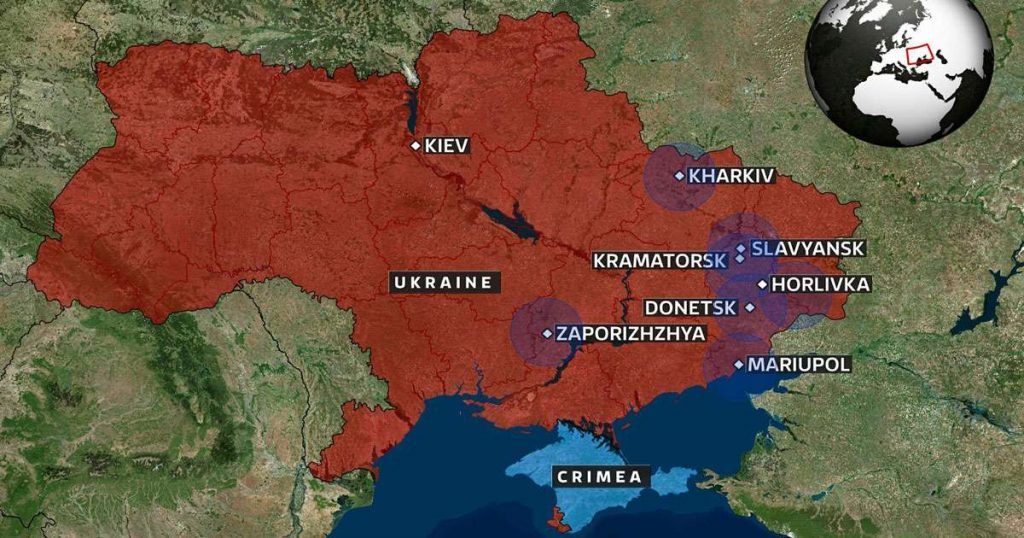
The US agenda was made plain in September 2013, when Carl Gershman, head of the CIA-tied National Endowment for Democracy, declared that “Ukraine is the biggest prize.” If Ukraine could be pulled into the US-led order, Gershman explained, “Putin may find himself on the losing end not just in the near abroad but within Russia itself.” In short, in Washington’s eyes, regime change in Kyiv could redound to Moscow as well.
Again, Russia’s invasion cannot be excused, it also cannot be understood, and resolved, without acknowledging that the war in Ukraine did not start last month.
We can get a better perspective by understanding the situation and the facts that brought about this war, a war eight years in the making, it is essential to any resolution.
That question will be one for the international community after hostilities.
Putin is responsible for choosing to invade, the West is responsible for creating the situation that led to that decision.
We should look back and see how we got here and what went down the memory hole.
In doing so some themes will be repeated, but that’s the nature of pulling things back out of the memory hole, it also serves to show how the truth of then, was universal, while the truth of now is so hard to swallow.
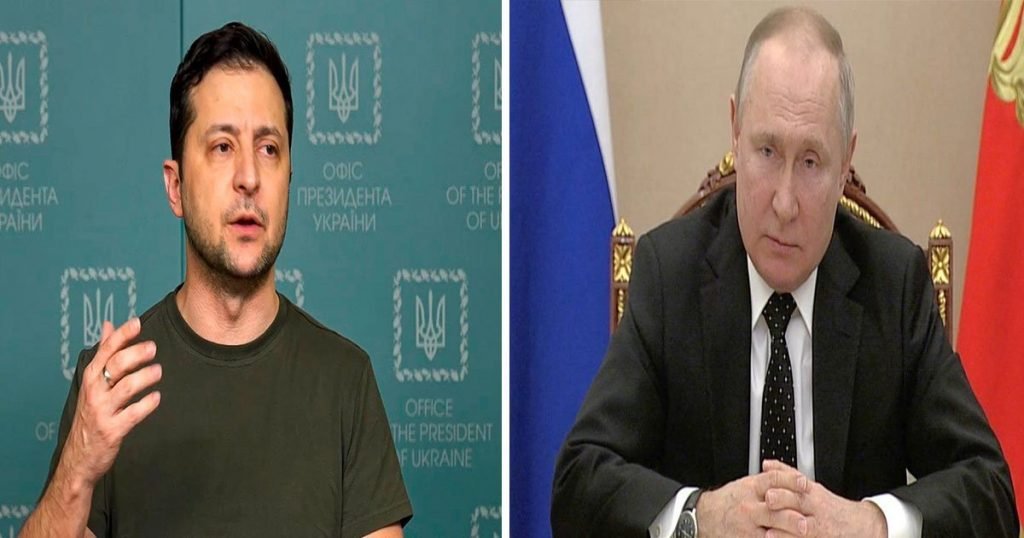
You can’t fix a problem you don’t understand. And right now, with Ukraine, the entire western political/media class is pouring a tremendous amount of energy into keeping people from understanding the problem.
In honesty, as a British working-class blogger, I don’t pretend to understand the nuances and complexities of Ukraine and its history, but I do remember the world before censorship or the western propaganda machine told me War is Peace.
Unfortunately, any dissent to the party line is often met with derogatory remarks and accusations of being Putin’s creature, however, I come from a generation that accepted criticising the Hegemony of the US or even our own government, didn’t make you a traitor or a foreign agent of some kind.
In fact, for the sake of full disclosure, I come from the generation that endured the original cold war, I was a British soldier that actually served in West Germany, in what at the time was one of the UK’s elite regiments, our very own nuclear regiment, in any outbreak of hostilities, we were the Russian military prime target in Western Europe. Our direct opposition, Spetsnaz troops, Russia’s version of the SAS. You can believe we spent a lot of time getting to know our enemy, learning how to combat our enemy. But no matter my background, of course, I am now guilty of wrongthink…
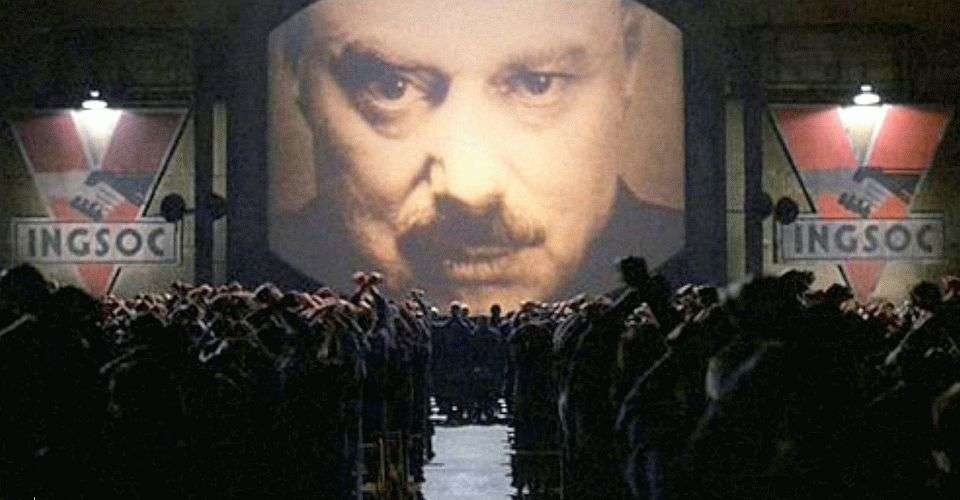
Wrongthink, that’s another Orwellianism. When “Nineteen Eighty-Four” was published, “memory hole” entered common parlance along with other Orwellisms like “Big Brother”, “Doublethink” and “Newspeak”, the idea of newspeak is defined throughout the book as being the controlled language created by the totalitarian government.
The purpose of newspeak was to suppress individual rights such as free speech and self-expression. An example of this is depicted, the slogans used “War is Peace, Freedom is Slavery, Ignorance is Strength”.
Even now I feel the Thought Police, readying their case to bin my article down the memory hole but for the sake of prosperity, let’s pull out some of the now censored media articles and try to grasp how Ukrianes’s recent far-right history is quickly disappearing.
Since our own government, along with the US, had one compulsion taking us into unjust war based on contrived evidence of WMD. We have a duty to examine the propaganda narrative of the political/media class.
Out of the memory hole
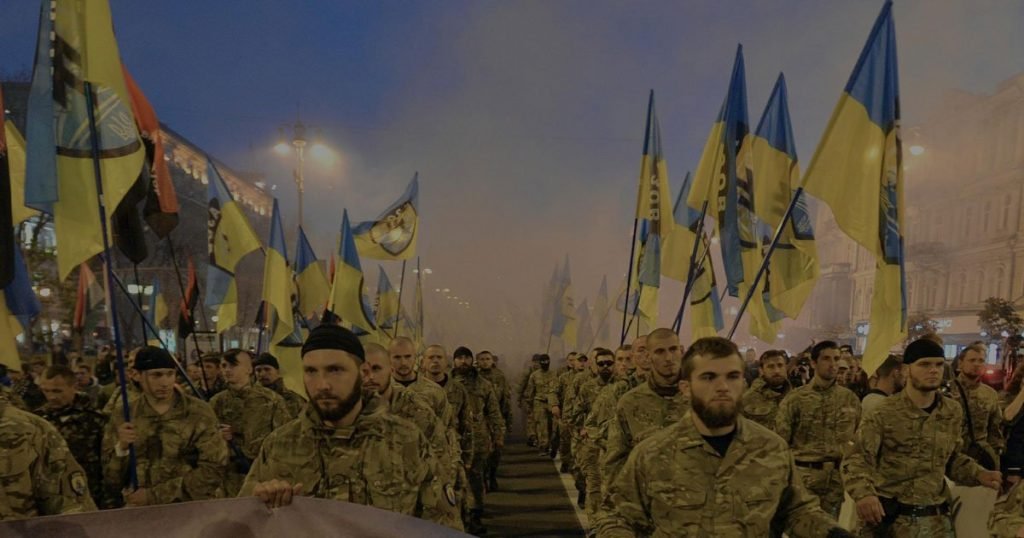
When Russian President Vladimir Putin declared war on Ukraine, he invoked ‘Nazism in Ukraine’ as one point of justification – a claim which the rest of the world categorically rejects, however, the evidence is clear, Jackboots are stomping across Kyiv square like its 1939.
This has become a constant point of contention on social media, for many commentators it seems in expressing concerns about the Far-right battalions in Ukraine like AZOV, we are guilty of thoughtcrime, a ‘wrongthink.’ However, it is in the public interest that people understand the players in this deadly game.
A deadly game that could soon engulf Europe if not the world.
To get there, as I keep emphasising, we have to understand this war didn’t begin on the 24th of February but goes way back to 2014.
This is a major escalation of a conflict that has raged for eight years, at the cost of more than 14,000 lives. Began with a US-backed, far-right-led 2014 coup that ousted Ukraine’s democratically elected government in Kyiv. In its place came a regime, chosen not by the Ukrainian people, but by Washington.
For the last eight years, we have had a constant barrage of programs and articles in the mainstream press explicitly relating to Ukraine’s Nazi problem.
Our screens have shown images of Ukraine nationalists moving from a well-funded, well-disciplined movement, to becoming organised far-right militia who have now been fully adopted into Ukraine’s military, it’s hard to ignore.
It’s also hard to ignore the montage of media on the subject is now being rapidly censored and disappearing online.
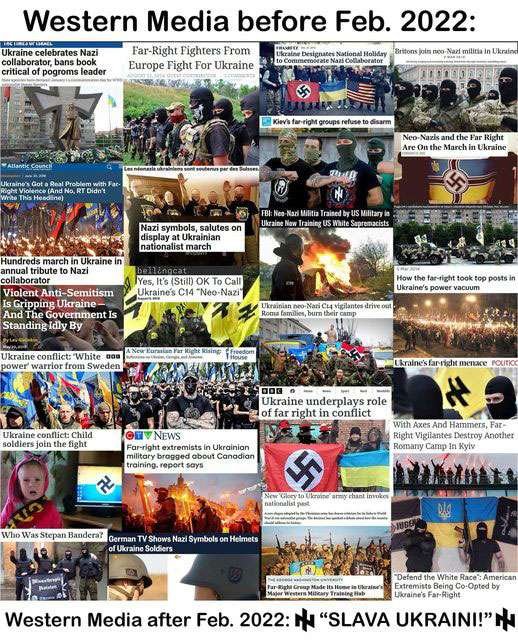
Material that was once churned out by the MSM becoming harder to find by the day. It’s important, especially when you understand the fact, ‘Denazification’ is one of Putin’s demands for Russian withdrawal and a peace prospect. Denying there is a Nazi issue only prolongs any steps towards peace.
Most European nations have a nationalist, extremist history (think Vichy France, Fascist Italy, Nazi Germany); even here in the UK, memories of Mosely’s Blackshirts and the battle of Cable street, still hold in the minds of our pensioners. But the difference is in the 21st century, we stomp down on the far right in this country, we de-platform them and take away their audience, we use legislation and the weight of the law, we don’t place them in government or adopt them into our armed forces.
This article in no way deters from Russia’s responsibility and part in this war, it only brings into question the Doublethink we have now to contend with when we are told, Nazis don’t exist in the Ukraine.

Ukraine on fire
This film by award-winning Oliver Stone ‘Ukraine on fire’ shows how the 2014’s Maidan Massacre triggered a bloody uprising that ousted president Viktor Yanukovych and painted Russia as the perpetrator by Western media. But was it? “Ukraine on Fire” by Igor Lopatonok provides a historical perspective for the deep divisions in the region which lead to the 2004 Orange Revolution, 2014 uprisings, and the violent overthrow of democratically elected Yanukovych.
Covered by Western media as a people’s revolution, it was in fact a coup d’état scripted and staged by nationalist groups and the U.S. State Department. Investigative journalist Robert Parry reveals how U.S.-funded political NGOs and media companies have emerged since the 80s replacing the CIA in promoting America’s geopolitical agenda abroad.
The coup government encouraged assaults on Ukraine’s Russian-speaking population, who took up arms to defend themselves with Moscow’s support. Rather than pressure its client in Kyiv to implement a negotiated settlement under the 2015 Minsk Accords, the US has instead poured in weapons and military advisers to assist Ukraine’s fascist-infused armed forces in the proxy war that it helped initiate.
At any other time, by any other state, we would have proclaimed the new Ukraine government illegitimate, a puppet government, however when it’s our puppet it’s absolutely legitimate, no questions asked.
US foreign policy ironically is now once again directed by the ‘The Council on Foreign Relations’ Joe Biden’s little group intent on shifting geopolitics into a new world order. Another NGO. A murky organisation of elitists that astonishingly Just like the Trilateral commission that Sir Keir Starmer Belongs to had Jeffrey Epstein in its ranks.
US foreign policy is often perceived abroad as a selfish exercise to further economic interests, largely driven by a huge energy demand. We would be remiss if we didn’t point out a few incontinent facts about Biden’s foreign policy that could see us all involved in a bloody conflict.
In 2014 Joe Biden was the White House’s go-to guy during the Ukraine crisis, touring former Soviet republics and reassuring their concerned leaders but he was not the only Biden involved in the region”.
The son of the then US Vice President Joe Biden, Hunter Biden joined the board of directors of Ukraine’s largest private gas company ‘Burisma’ which was controlled by a confidant of former Ukrainian President Viktor Yanukovych.
Biden joined the board of Burisma Holdings owned by Ukrainian oligarch and former politician Mykola Zlochevsky, who was facing a money-laundering investigation just after the Ukrainian revolution, in April 2014.
At the time the move raised some eyebrows in the US, given the Obama administration’s attempts to manage the ongoing crisis in Ukraine.
Less well known, but potentially more sinister, are Mykola Zlochevsky reported ties — by way of his position with Burisma — to Ukraine’s most thuggish billionaire, the larger-than-life Kolomoisky.
In 2015, veteran Russian writer and investigator John Helmer, author of “The Man Who Knows Too Much About Russia”, suggested that Zlochevsky and Pozharskyi were front men for Kolomoisky at Burisma.
He is not the type of “businessman” the Bidens would want to be associated with, said one Ukraine expert. In August, the U.S. Justice Department accused Kolomoisky of robbing billions from the Privat Group bank he owned and using the many companies he has all over the world, including the U.S. to launder it.
The Bond villain-like Kolomoisky, 57, reportedly kept a live shark in a huge tank in his office to intimidate visitors, and once called the 5-foot-7 Russian President Vladimir Putin a “schizophrenic dwarf”.
But his bloodthirstiness reportedly matched his bravado. He crushed Russian separatists with his own private armies, according to numerous Ukrainian and international media reports, and he allegedly ordered contract killings, including a hit on a Ukrainian lawyer as well as the murders of gang members involved in the hit, the Daily Beast reported.
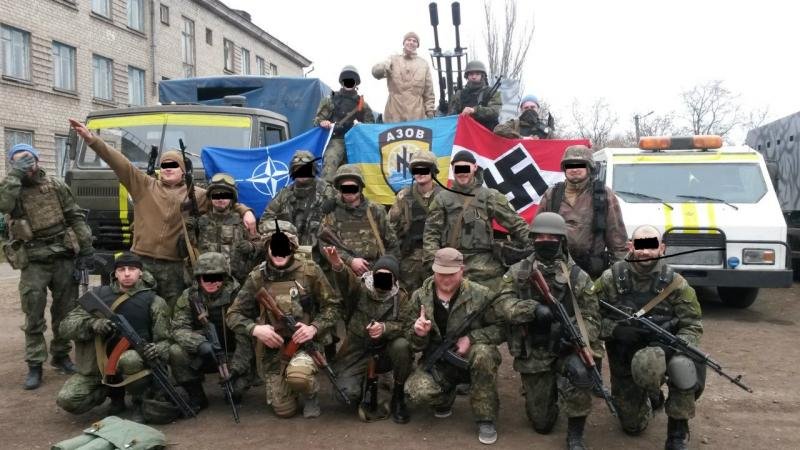
Some of the allegations surfaced in UK court proceedings in a case ultimately settled out of court, the Telegraph reported.
Kolomoisky has never been charged with murder. He has refuted such allegations and also denied involvement with Burisma. Mike Sullivan, a U.S.-based attorney for Kolomoisky, did not return phone calls or emails from The Post.
He has three nationalities — Ukrainian, Cypriot and Israeli — and is reportedly worth about $1.2 billion. He backed the election last year of Ukraine’s current president, Volodymyr Zelensky, a TV comedian known for, among other things, playing the piano with his penis.
“Kolomoisky was a known thug in his business practices and his organizing of armed militias”, Russ Bellant, an expert on Ukraine and the author of “Old Nazis, the New Right and the Republican Party”, told The New York Post.
Bellant, Helmer and writer Richard Smith have said that Kolomoisky’s shady Privat Group may have owned some or part of Burisma, though no one has proven it.
In 2019 Bellant went so far as to refer to Kolomoisky as the head of Burisma in an essay.
He said he was writing about the Bidens and Ukraine as a way to “unburden myself and tell this to those who care about Ukraine’s election”.
Biden, Ukraine and the Nazis
What better way than to use Nazis to intimidate and anger Russia?
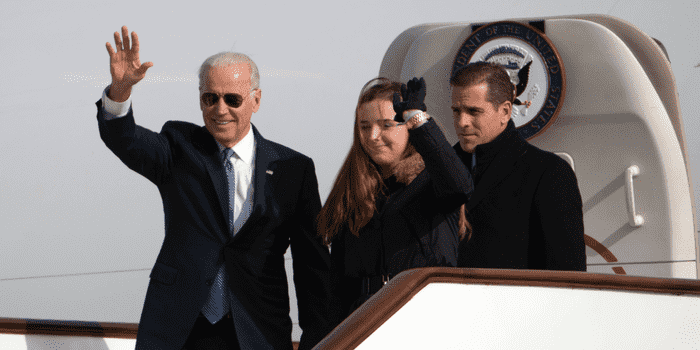
Reuters
In 2013, the United States put pressure on Ukraine to align with the European Union and distance itself from Russia. But Russia offered Ukraine a better aid package and the Ukrainian president decided to go with Russia, a nation that he was always friendly towards anyways. The US, using Ukrainian intelligence assets developed after WWII, organized large demonstrations with violence against the police and against the government and eventually collapsed the government, forcing the president to flee Ukraine. In 2013 Joe Biden went to Kyiv, the Ukrainian capital, and warned the government not to harm the demonstrators. That act made clear to the world that the US was allied with them, if not orchestrating the demonstrations and then the subsequent coup against the elected government.
As Vice President, Biden was tasked with being the political officer for the takeover of Ukraine, much as VP Nixon did for Eisenhower in preparing for the Bay of Pigs and as Pence is doing now in Latin America. But eastern Ukrainians resented the coup and refused to accept the new regime that the US put in place. The Ukrainian military was ambivalent about repressing these citizens, with one airborne battalion even joining the resistance. So the US began supporting the creation of militia units outside of the established military chain of command, using the Kyiv demonstrators as their manpower source. This is where young Biden comes in.
The core of the demonstrators were members of the Organization of Ukrainian Nationalists cofounded by Stephan Bandera (OUN-B is their shorthand), an organization that adopted a national socialist ideology and was allied with Hitler during the war and was picked up, funded and supplied by the CIA after the war. These new allies continued military operations against the Soviet Union until 1950. During WWII, OUN-B created and led military units that burned and exterminated whole villages of Poles ( about 100,000 killed) and Jews, with a toll of about 1,500,000. In other words, they were psychotic killers.
The OUN-B was integrated into Radio Free Europe operations and political organizations were set up in the US and abroad to give them more influence and reach. But in the entire post-war period, the OUN-B still glorified their World War II leaders. When the USSR collapsed, the US helped bring to power a Ukrainian government that erected many statues to honour Bandera and started pensions for WWII Nazi veterans that were still alive. Europeans condemned the Nazi revival, but the US was silent.
According to (a Google Translation of) the Youth Nationalist Congress (MNK) website, the group “represents the views of the OUN-B in the youth environment… Since 2008, the MNK has been implementing projects in partnership with the Ministry of Youth and Sports of Ukraine…” pic.twitter.com/DrlQw5Nybp
— Bandera Lobby Blog (@mossrobeson__) June 1, 2019
From this milieu grew young generations of OUN-B adherents to continue the war against Russia launched by Hitler and their ancestors. When they demonstrated in Kiev in 2013, their Nazi symbols were there to see, once described by the New York Times. When they formed battalions, the symbols remained. The most conspicuous of these battalions was the Azov battalion, which used symbols of the German 2nd SS Panzer Division from WWII. Some wore Ku Klux Klan symbols reflecting a trans-Atlantic relationship. When Azov was formed to attack the east Ukrainians, the question arose about funding to arm them.
Enter Burisma, the natural gas conglomerate, headed by Ihor Kolomoisky — a citizen of Ukraine, Cyprus (the money-laundering capital of Europe), Austria and Israel. Known for business practices that would bring to mind Al Capone, he took over Ukrainian gas companies, funded politicians and was the poster boy of corruption in a country ranked by the World Economic Forum as one of the most corrupt on the planet.
Burisma became the funding conduit as Azov’s weaponry went from clubs and chains to trucks and heavy machine guns, to artillery and tanks. On their website, they would portray their new wealth as contributions from grateful citizens. As they formed they were moved east to start killing rebelling Ukrainians.
It was at this time, in May of 2014, that Hunter Biden was put on the board of Burisma, as was Devon Archer, a financial adviser to then-Secretary of State John Kerry. Thereafter the largesse to Azov increased. So conspicuous was their growth that Congressman John Conyers initiated a bill to ban CIA funding of nazis in the Ukraine, which passed unanimously. The Azov website was taken down. Months later the administration reached out to Congressional Republican leadership and got the Conyers bill repealed.
NEW: The BIDENS are entangled in a Ukrainian corruption scandal:@JoeBiden pushed Ukraine to fire a prosecutor seen as corrupt.
— Kenneth P. Vogel (@kenvogel) May 2, 2019
BUT the prosecutor had opened a case into a company that was paying HUNTER BIDEN.
The Bidens say they never discussed it. https://t.co/tblUPYPJMG
Hunter Biden, who had no background in utilities or European markets, was reportedly paid $3 million to attend Burisma board meetings. If Joe Biden was the Democratic nominee and the Burisma/nazi story was told, questions would be raised about whether Joe got some of that money…and how his unqualified son got on the board of a US funding conduit when his father was the overseer of the operation. Was some of that $3 million actually US taxpayer money? And what do Hunter and Joe know about Burisma’s role in the burning and shooting deaths of over 100 people in a trade-union building in Odesa… and moving a Burisma-funded paramilitary unit into a region where Burisma’s interests were being challenged by Ukrainian regional authorities. Burisma won that fight.
When Biden was asked a question by an Iowan citizen about the Burisma ties, Biden blew up at him in front of the press and thus Iowa voters. He thereafter dived in the polls. Can you see that getting replayed in a general election if he was the brokered nominee? It will be if the GOP gets its way. The death toll in Ukraine from the civil war that Biden helped midwife is now over 14,000, with cities destroyed. Can he justify that? What has saved him to date is that no one knows and thus no one asks.
Let’s talk about Ukraine’s “Nazi problem”: The Azov Movement
In October 2014 members of Azov and other similar organisations marched in their thousands through the streets of the capital Kyiv.
The Azov brigade marched with heavy metal music blaring out, shouting slogans, urging people to follow them. Watch the video below.
The Washington-backed opposition that toppled the government was fuelled by far-right and openly Nazi elements like the Right Sector. One far-right group that grew out of the protests was the Azov Battalion, a paramilitary militia of neo-Nazi extremists. Their leaders made up the vanguard of the anti-Yanukovych protests and even spoke at opposition events in the Maidan alongside US regime change advocates like McCain and Nuland.
After the violent coup, these groups were later incorporated into the Ukrainian armed forces—the same armed forces that the US has now given $2.5 billion. Though Congress technically restricted money from flowing to the Azov Battalion in 2018, trainers on the ground say there’s no mechanism to actually enforce the provision. Since the coup, the Ukrainian nationalist forces have been responsible for a wide variety of atrocities in the counterinsurgency war.
Far-right influence has increased across Ukraine as a result of Washington’s actions. A recent UN Human Rights Council has noted that “fundamental freedoms in Ukraine have been squeezed” since 2014, further weakening the argument that the US is involved in the country on behalf of liberal values.
Ukraine’s bloody conflict against the Donbas separatists in the east of the country has led to thousands of deaths – it also showed the face of the far-right groups and militia who seem to dominate Ukraine.
People who believe this conflict started on February 24th 2022 are as naïve as the people who believed the UK’s inequality and poverty crisis or even the privatisation of the NHS started on 23 Jun 2016.
“To become an Azov fighter, you have to be a proper white man”.
Azov Battalion fighter
Senior members of the battalion were given influential positions within Petro Poroshenko’s government. Its commander, Andriy Biletsky, is believed to be in charge of two neo-Nazi political groups, and has been elected to serve in Ukraine’s parliament while the battalion itself has been integrated into the country’s National Guard.

When Putin talks about Nazis in Ukraine, he is talking about Andriy Biletsky, the 42-year-old founder of the Azov Battalion, who is thought to be fighting against Russian troops somewhere near Kyiv.
It was Biletsky who said in 2010 that his country’s mission was to “lead the white races of the world in a final crusade . . . against Semite-led Untermenschen”, or inferior races.
Differences between Ukraine’s far-right groups have been put aside as the fighting continues, though one fighter – a teacher and psychologist – told Kemp that to become an Azov fighter you had to be “a proper white man. You can be nationalist, you can be fascist or national socialist. It’s not the main thing”
“Our future is a war – a war with Russia.
Wearing Nazi-inspired insignia such as the Wolfsangel on the uniforms of its fighters, who have been photographed with Nazi symbols on their helmets, the Azov “is known for its association with neo-Nazi ideology… and is believed to have engaged in training and radicalization”, of white supremacist organizations in the United States”, according to an FBI indictment against several white nationalists in the United States who travelled to Kyiv to receive Azov training.
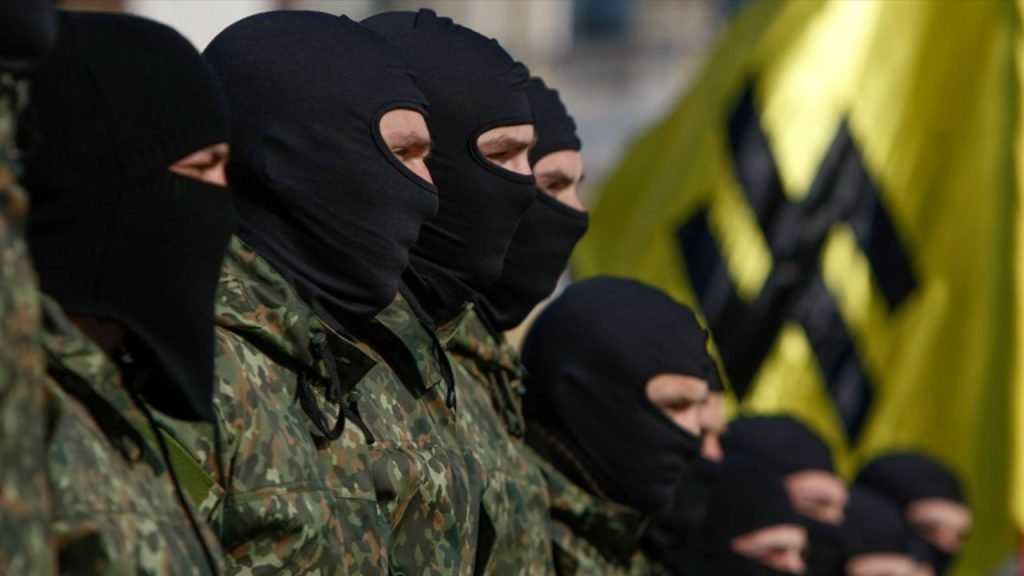
Stepan Bandera, Ukraine Hero, Nazi Collaborator
“The terms ‘nazism’ and ‘fascism’ evoke, in the Russian context, absolute evil that you cannot bargain with”, said Sergei Fediunin, a political scientist at France’s National Institute for Oriental Languages and Civilisations.
“The only option is to fight and destroy it”.
Russia also targets the Ukrainian nationalists who fought Soviet Russia after 1945 and their leader, Stepan Bandera, who collaborated with Nazi Germany.
Stepan Bandera led the Ukrainian Insurgent Army, which fought alongside Nazi Germany during WWII, killing thousands of Jews and Poles
There are few figures in Ukrainian history as controversial as Stepan Bandera, and fewer still are able to influence so profoundly modern politics more than six decades after their death.
Bandera, who died in 1959 after being poisoned by Soviet agents, is seen as a national hero who fought for Ukrainian independence during the 1930s and 1940s. To others, he is a war criminal whose nationalist forces carried out atrocities against Jews and Poles during WW2.

The authorities in Lviv, in western Ukraine, last year reignited the debate over the wartime militia leader by requesting the government to rename Arena Lviv in honour of Bandera and forcing Ukrainian President Volodimir Zelenskyy to pick a side during a bitter election battle.
“They are pressuring Zelenskyy and [Denys] Shmygal, the prime minister, to decide if they are nationalist or not”, said Alexei Jakubin, a senior politics lecturer at Kyiv Polytechnic Institute.
Zelenskyy, who won the 2019 election in Ukraine by a landslide with over 70% of the vote, was at the time polling at just 19%.
Lviv’s authorities, dominated by right-wing parties including Svoboda and European Solidarity, the party of former president Petro Poroshenko, who smell blood, it was stated:
“Zelenskyy and Poroshenko have a fight going on about who is the most patriotic [and] Zelenskyy is in a difficult position because his support is much lower he is moving [towards] the right wing, which is the territory of Poroshenko”, said Jakubin.
“This is a test to see whether or not he is a real patriot”, he added.
It’s the usual gotcha culture of today, one wrong move, one wrong social media comment, joke or meme and you’re cancelled, or in the case of a politician, you’re out.
It is not the first time by any means that a war over Bandera’s legacy has been waged in the highest echelons of Ukrainian politics.
In 2010, Bandera was named a “Hero of Ukraine” by the outgoing President Viktor Yushchenko, sparking anger in Europe, Poland and Israel.
He was stripped of the title in 2011 under Yushchenko’s replacement, President Viktor Yanukovych, but when Yanukovych was ousted in 2014, Kyiv’s City Council renamed the city’s Moscow Avenue Stepan Bandera Avenue after the Russian invasion of eastern Ukraine.
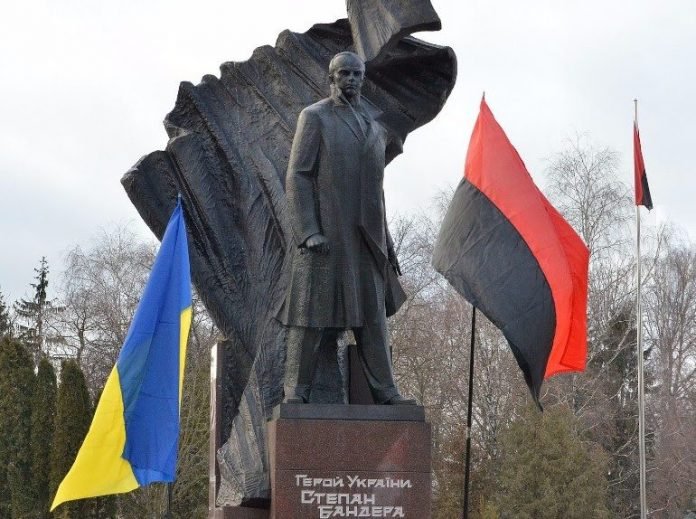
There are monuments to Bandera throughout western Ukraine and in 2018, the authorities in Lviv, just 46 miles from the Polish border, announced that 2019 would be the ‘Year of Stepan Bandera’, again sparking protests from Israeli and the Polish government.
Following World War One, Poland and Ukraine fought a short war which resulted in Poland capturing the city of Lviv. Bandera, who studied in Lviv, was a member of various nationalist Ukrainian organisations before joining the Organization of Ukrainian Nationalists (OUN), becoming second in command of the militia group in 1933.
The following year, Bandera orchestrated the assassination of the Polish Minister of Interior Bronisław Pieracki and was sentenced to death by a Polish court, later commuted to life imprisonment. When the Nazis invaded Poland, Bandera and other nationalists escaped from prison.
Bandera was trained by the German Abwehr to do counter-espionage in the Soviet Union, occupied Poland and Ukraine, which he did until 1941. That year, Bandera and his followers signed a declaration of independence for Ukraine and announced an alliance with Nazi Germany.
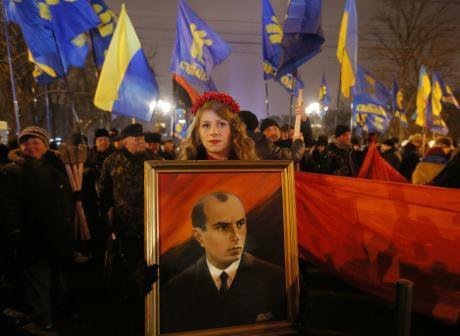
Bandera was the leader of a Ukrainian nationalist movement in the 1930s and 1940s, which included a rebel army that fought alongside the Nazis. Bandera’s supporters claim that they sided with the Nazis against the Soviet army in the belief that Adolf Hitler would grant independence to Ukraine.
Jewish groups associate Bandera’s followers with the massacre of Jews.
Since the 2014 Euromaidan revolution, Bandera has been a rallying cry for many Ukrainian nationalists, particularly after the Russian annexation of Crimea and the backing of separatist movements in eastern Ukraine.
“The main thing for the people following Bandera today is that he fought for an independent Ukraine. They ignore that his organization cooperated with the Nazi regime, that they were anti-Semitic, and that Bandera was also anti-Polish”, said Jakubin.
“After Euromaidan, some people have tried to create a new image of Bandera as a person fighting the Soviets for Ukrainian independence”.
The lesson learnt from the reels of B movies is that resurrection of Nazi Zombies never turn out well for the locals.
Recipe for a wider European war
The fighting in the breakaway regions of Donbas was described by NATO as the biggest threat to European security since the Second World War.
We can examine some of the media we were spoon feed before the outbreak of war and all the Nazis ended up down the memory hole. Ros Kemp met members of the Azov Battalion near Mariupol – which just months before they had seized pro-Russian separatists.
BAFTA-winning filmmaker Ross Kemp saw first-hand how militias, made up of football hooligans and current and former soldiers, are now fighting on the front line. Just a few years ago they were on the fringes of society – shunned for their violent behaviour and xenophobic beliefs, but since the 2014 Maidan revolution – and the subsequent fighting against pro-Russian groups – their popularity has grown.
During filming for series four of Extreme World, Kemp met a group of Dynamo Kyiv “ultras” who took part in 2014 uprisings that with CIA backing overthrow the government of Ukraine and now fight on the front line in a deadly civil war.
Ross Kempt Extreme World Ukraine
Today, Russian troops press hard on cities like Mariupol, which was effectively under the control of the Azov Battalion.
The country’s second-largest seaport, the city is now the front line, and its industry is vital to Ukraine’s economy.
But Mariupol is also a pivotal target in Putin’s war – providing a land bridge between Russian forces in Crimea to the southwest and Russian-controlled territory to the north and east.
A landgrab will ultamlu result. It would be hard to see how Russia would ever give up this prize, even after any negotiated peace.
Hey, wait Zelensky has a Jewish background, what’s all this Nazi business?
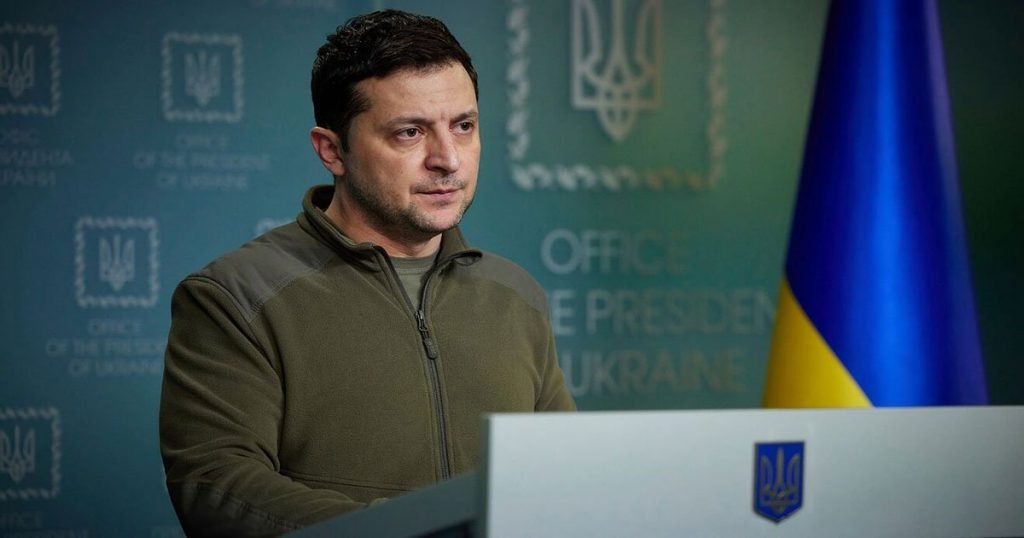
While now hailing Ukrainian President Volodymyr Zelensky as a national hero, the US has sided with far-right Ukrainian nationalists over the peace platform that Zelensky was elected on in 2019. Slipping roles from comedy to tragedy it seems Zelensky the former actor has little choice but to play his part.
Hours before President Putin’s February 24 speech declaring denazification the goal of Russian operations, Volodymyr Zelensky, according to the BBC, “asked how a people that has lost eight million of its citizens fighting the Nazis could support to Nazism”.
Raised in a non-religious Jewish family in the Soviet Union in the 1980s, Zelensky has in the past nuanced his heritage. “The fact that he is Jewish is hardly another item on my long list of faults”, he joked in a 2019 interview in which he declined to delve into the details of his religious background.
Zelensky is no longer shy about promoting his Jewish ancestry. “How could I be a Nazi?” he wondered out loud in a public speech. For the US media engaged in an all-out war against Russia, the president’s religious identity has now become an essential public relations tool.
Alex Rubinstein an independent reporter on Substack and Max Blumenthal, editor-in-chief of The Grayzone, published an in-depth insight into Volodymyr Zelensky’s relationship with the far right.
They point out how when Zelensky came to power in May 2019, the Azov Battalion maintained de facto control of the strategic port city of Mariupol in the southeast of the country, as well as its surrounding towns. As Open Democracy pointed out, “Azov has undoubtedly established political control in the streets of Mariupol.
To maintain this control, they have reacted violently, even if not officially, against any public event that strays far enough from the organization’s political agenda”.
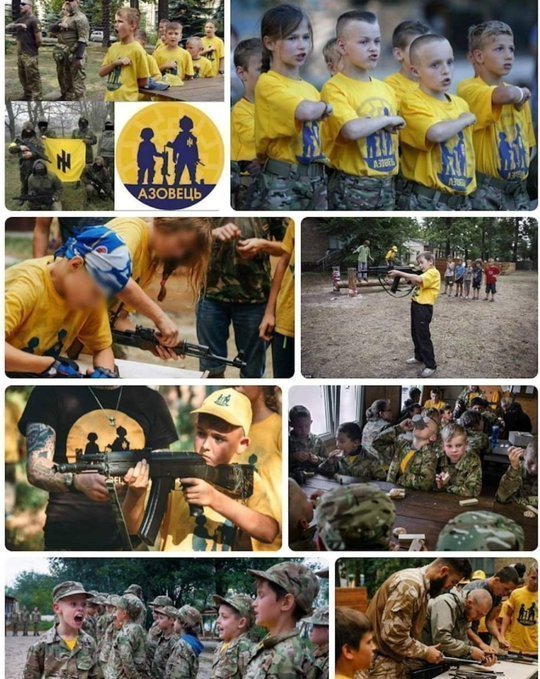
In October 2019, while the war in eastern Ukraine dragged on, the country’s president, Volodymyr Zelensky, travelled to Zolote, a town clearly located in the “grey area” of the Donbas, where more than 14,000 people have died, mostly on the Russian side.
There, the president met paramilitary units, battle-hardened far-right veterans, who were fighting the separatists a few miles from the rally point.
Zelensky visited the country’s eastern frontline in April 2021 after a recent surge in clashes between Ukrainian troops and #Russia-backed separatists. The visit came amid rising tensions, with Russian President Vladimir Putin accusing Kyiv of provocative action during a phone call with German Chancellor Angela Merkel.
Chosen for representing a platform for the de-escalation of hostilities with Russia, Zelensky was determined to reinforce the so-called Steinmeier Formula, conceived by then-German Foreign Minister Walter Steinmeier, which called for elections in the Russian-speaking regions of Donetsk and Lugansk.
In a face-to-face confrontation with militants from the neo-Nazi Azov Battalion who had launched a campaign of sabotage against the so-called “No to Capitulation” peace initiative, Zelensky ran into a wall of intransigence.
It started as an argument. On Oct. 26, President Volodymyr Zelensky locked horns with war veterans in the front-line town of Zolote in Luhansk Oblast.
President of Ukraine Zelensky has visited disengaging area in Zolote today https://t.co/scFZLt45C2 pic.twitter.com/JlD1cWPQ39
— Liveuamap (@Liveuamap) October 26, 2019
Zelensky despaired in front of the cameras when appealing for withdrawal at the front, being firmly rejected.
“Listen, Denys, I’m the president of this country. I’m 41 years old. I’m not a loser. I came to you and told you: remove the weapons. Don’t shift the conversation to some protests”, Zelensky said, videos of the exchange show. As he said this, Zelensky aggressively approached Yantar, who heads the National Corps, a political offshoot of the far-right Azov volunteer battalion, in Mykolaiv city.
“But we’ve discussed that”, Yantar said.
“I wanted to see understanding in your eyes. But, instead, I saw a guy who’s decided that this is some loser standing in front of him”, Zelensky said.
The president was pushing a mutual disengagement of troops and armaments at the front line flashpoint. The veterans opposed this plan.
As the video of the stormy confrontation spread on social media across Ukraine, Zelensky became the subject of a furious backlash.
Andriy Biletsky, the leader of the Azov Battalion, a proud fascist who once swore “to lead the white races of the world in a final crusade…against the Untermenschen (sub-humans) led by Semites”, Zelensky’s further pressure promised to bring to Zolote thousands of fighters. Meanwhile, a deputy from former president Petro Poroshenko’s party openly fantasized about a Zelensky being blown to pieces by a militant’s grenade.
Despite the fact that Zelensky managed to agree to a minor de-escalation, the neo-Nazi paramilitaries escalated their “No to capitulation” campaign. And in a few months, the conflict began to heat up again in Zolote, provoking a new cycle of violations of the Minsk Agreements.
Nationalism is a potent force and when faced by a perceived enemy a country will unite and turn on anyone who is seen to be attacking their forces, including at that time their own president.
In November 2021, one of the most notable ultra-nationalist militiamen, Dmytro Yarosh, announced that he had been appointed as an adviser to the commander-in-chief of the Ukrainian armed forces. Yarosh is a well-known supporter of the collaborationist Bandera who led the Right Sector from 2013 to 2015, vowing to lead the “de-Russification” of Ukraine.

By now, the Azov had been formally incorporated into the Ukrainian military and its street surveillance wing, known as the National Corps, was deployed throughout the country under the supervision of the interior minister, alongside the National Police. In December 2021, Zelensky could be seen presenting the “Hero of Ukraine” decoration to a leader of the fascist Right Sector, at a ceremony in the country’s parliament.
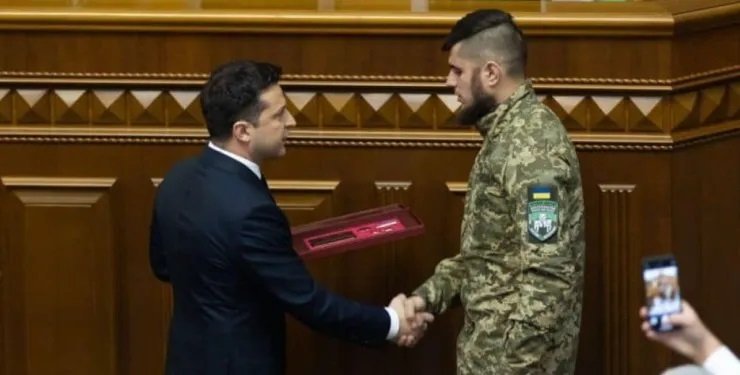
Zelensky seems to have been publicly browbeaten into submission during his confrontation with elements of the Azov last year, at the moment any attempts at denazification would be an impossibility.
A full-scale conflict with Russia is underway, and the distance between Zelensky and the extremists has in necessity all but disappeared.
After his failed attempt to demobilize neo-Nazi militants in the town of Zolote in October 2019, the Ukrainian president called on fighters for dialogue, telling reporters “I met with the veterans yesterday. Everyone was there: the National Corps, Azov, everyone else”.
A few seats away from the Jewish president was Yehven Karas, the leader of the neo-Nazi clique C14.

In the course of the Maidan “Revolution of Dignity” that toppled Ukraine’s president-elect in 2014, C14 activists took over Kyiv’s city hall, covering its walls with neo-Nazi insignia before taking refuge in the Canadian embassy.
As the former youth wing of the ultra-nationalist Svoboda party, C14 seems to take its name from the infamous 14 words of (US) neo-Nazi leader David Lane: “We have to ensure the existence of our people and the future of white children”.
Offering to carry out acts of spectacular violence on behalf of anyone willing to pay, they have harboured quite comfortable relationships with various government institutions and powerful elites throughout Ukraine.

A March 2018 Reuters report stated that “C14 and the Kyiv city government recently signed an agreement allowing C14 to set up a ‘municipal guard’ to patrol the streets”, effectively giving them state approval to carry out pogroms.
As reported by The Grayzone, C14 led an assault to “purge” the Kyiv railway station of Roma, in collaboration with the city’s police.
Zelensky: “His life is being threatened literally by a quasi-fascist movement in Ukraine.”
In 2019, Zelensky was elected on an overwhelming mandate to make peace with Russia. As Stephen F. Cohen warned that year, the US chose to side with Ukraine’s far-right and fuel war.
On a warm October day in 2019, the eminent Russia studies professor Stephen F. Cohen and I sat down in Manhattan for what would be [our last in-person interview] (Cohen [passed away in September 2020 at the age of 81)).
The House was gearing up to impeach Donald Trump for freezing weapons shipments to Ukraine while pressuring its government to investigate Joe Biden and his son Hunter. The Beltway media was consumed with frenzy of a presidency in peril. But Professor Cohen, one of the leading Russian scholars in the United States, was concerned with what the impeachment spectacle in Washington meant for the long-running war between the US-backed Ukrainian government and Russian-backed rebels in the Donbas.
At that point, Ukraine’s Volodymyr Zelensky was just months into an upstart presidency that he had won on a pledge to end the Donbas conflict. Instead of supporting the Ukrainian leader’s peace mandate, Democrats in Congress were impeaching Trump for briefly impeding the flow of weapons that fueled the fight. As his Democratic allies now like to forget, President Obama [refused to send and [arming Nazis]. By abandoning Obama’s policy, the Democrats, Cohen warned, threaten to sabotage peace and strengthen Ukraine’s far-right.
“Zelensky ran as a peace candidate,” Cohen explained. “He won an enormous mandate to make peace. So, that means he has to negotiate with Vladimir Putin.” But there was a major obstacle. Ukrainian fascists, Cohen warned, “have said that they will remove and kill Zelensky if he continues along this line of negotiating with Putin… His life is being threatened literally by a quasi-fascist movement in Ukraine.”
Peace could only come, Cohen stressed, on one condition. “[Zelensky] can’t go forward with full peace negotiations with Russia, with Putin, unless America has his back,” he said. “Maybe that won’t be enough, but unless the White House encourages this diplomacy, Zelensky has no chance of negotiating an end to the war. So the stakes are enormously high.”
Zelensky: “His life is being threatened literally by a quasi-fascist movement in Ukraine.”
In 2019, Zelensky was elected on an overwhelming mandate to make peace with Russia. As Stephen F. Cohen warned that year, the US chose to side with Ukraine’s far-right and fuel war.
On a warm October day in 2019, the eminent Russia studies professor Stephen F. Cohen and I sat down in Manhattan for what would be [our last in-person interview] (Cohen [passed away in September 2020 at the age of 81)).
The House was gearing up to impeach Donald Trump for freezing weapons shipments to Ukraine while pressuring its government to investigate Joe Biden and his son Hunter. The Beltway media was consumed with frenzy of a presidency in peril. But Professor Cohen, one of the leading Russian scholars in the United States, was concerned with what the impeachment spectacle in Washington meant for the long-running war between the US-backed Ukrainian government and Russian-backed rebels in the Donbas.
At that point, Ukraine’s Volodymyr Zelensky was just months into an upstart presidency that he had won on a pledge to end the Donbas conflict. Instead of supporting the Ukrainian leader’s peace mandate, Democrats in Congress were impeaching Trump for briefly impeding the flow of weapons that fueled the fight. As his Democratic allies now like to forget, President Obama [refused to send and [arming Nazis]. By abandoning Obama’s policy, the Democrats, Cohen warned, threaten to sabotage peace and strengthen Ukraine’s far-right.
Zelensky cannot make peace when he has a gun to his head.
Zelensky: “His life is being threatened literally by a quasi-fascist movement in Ukraine.”
In 2019, Zelensky was elected on an overwhelming mandate to make peace with Russia. As Stephen F. Cohen warned that year, the US chose to side with Ukraine’s far-right and fuel war.
On a warm October day in 2019, the eminent Russia studies professor Stephen F. Cohen and I sat down in Manhattan for what would be [our last in-person interview] (Cohen [passed away in September 2020 at the age of 81)).
The House was gearing up to impeach Donald Trump for freezing weapons shipments to Ukraine while pressuring its government to investigate Joe Biden and his son Hunter. The Beltway media was consumed with frenzy of a presidency in peril. But Professor Cohen, one of the leading Russian scholars in the United States, was concerned with what the impeachment spectacle in Washington meant for the long-running war between the US-backed Ukrainian government and Russian-backed rebels in the Donbas.
At that point, Ukraine’s Volodymyr Zelensky was just months into an upstart presidency that he had won on a pledge to end the Donbas conflict. Instead of supporting the Ukrainian leader’s peace mandate, Democrats in Congress were impeaching Trump for briefly impeding the flow of weapons that fueled the fight. As his Democratic allies now like to forget, President Obama [refused to send and [arming Nazis]. By abandoning Obama’s policy, the Democrats, Cohen warned, threaten to sabotage peace and strengthen Ukraine’s far-right.
“Zelensky ran as a peace candidate,” Cohen explained. “He won an enormous mandate to make peace. So, that means he has to negotiate with Vladimir Putin.” But there was a major obstacle. Ukrainian fascists, Cohen warned, “have said that they will remove and kill Zelensky if he continues along this line of negotiating with Putin… His life is being threatened literally by a quasi-fascist movement in Ukraine.”
Peace could only come, Cohen stressed, on one condition. “[Zelensky] can’t go forward with full peace negotiations with Russia, with Putin, unless America has his back,” he said. “Maybe that won’t be enough, but unless the White House encourages this diplomacy, Zelensky has no chance of negotiating an end to the war. So the stakes are enormously high.”
Zelensky’s main financier also funds neo-Nazis
Attached to the Ukrainian National Guard, the Azov Battalion is considered the most fanatically ideological and militarily motivated detachment fighting pro-Russian separatists in the Donbas region.
Energy oligarch of Jewish descent Igor Kolomoisky has been one of the main financiers of Azov since its formation in 2014. He has also shelled out money for private militias such as the Aidar and Dnipro Battalions, singling them out as his personal shock squad for the protection of his financial interests.
The business insider claimed the recruits came from Ukraine and Europe. There are even a couple of Americans. Estimates suggest Kolomoisky could call on over 20,000 troops and reserves. His Dnipro Battalion, also known as Dnipro-1, includes around 2,000 heavily armed fighters.
The unit is reported to have cost the banking billionaire $10 million to set up. They helped play a key role in halting the advance of the Moscow-backed rebels from their strongholds in the neighbouring Donetsk and Luhansk.
However, there are doubts about where the troops’ ultimate loyalties lie — to the government in Ukraine or to their regional paymaster. in 2015, armed men in masks stormed the headquarters of state-owned oil company UkrTransNafta in the Ukrainian capital Kyiv, following the sacking of its director Oleksander Lazorko, a key ally of Kolomoisky.
This is rule by oligarchy. Like Russia, Ukraine it seems is a gangster run country.
These forces were privately funded by oligarchs – the most known being Igor Kolomoisky, an energy magnate billionaire and then-governor of the Dnipropetrovska region.
In addition to Azov, Kolomoisky funded other volunteer battalions such as the Dnipro 1 and Dnipro 2, Aidar and Donbas units.
Azov received early funding and assistance from another oligarch: Serhiy Taruta, the billionaire governor of the Donetsk region.
Neo-Nazi ideology
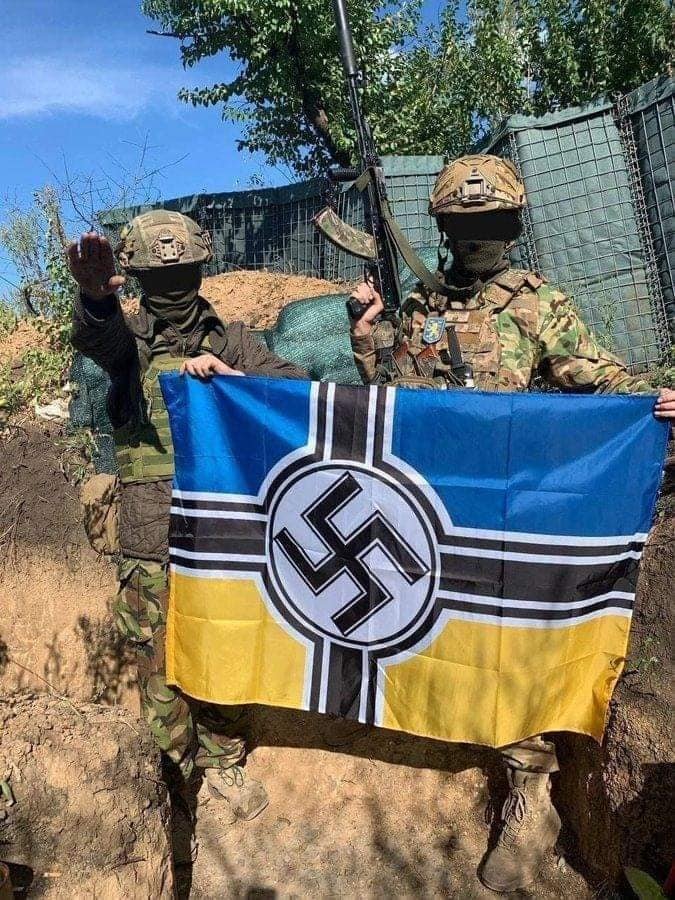
In 2015, Andriy Diachenko, the spokesperson for the regiment at the time said that 10 to 20 percent of Azov’s recruits were Nazis.
The unit has denied it adheres to Nazi ideology as a whole, but Nazi symbols such as the swastika and SS regalia are rife on the uniforms and bodies of Azov members.
For example, the uniform carries the neo-Nazi Wolfsangel symbol, which resembles a black swastika on a yellow background. The group said it is merely an amalgam of the letters “N” and “I” which represent “national idea”.
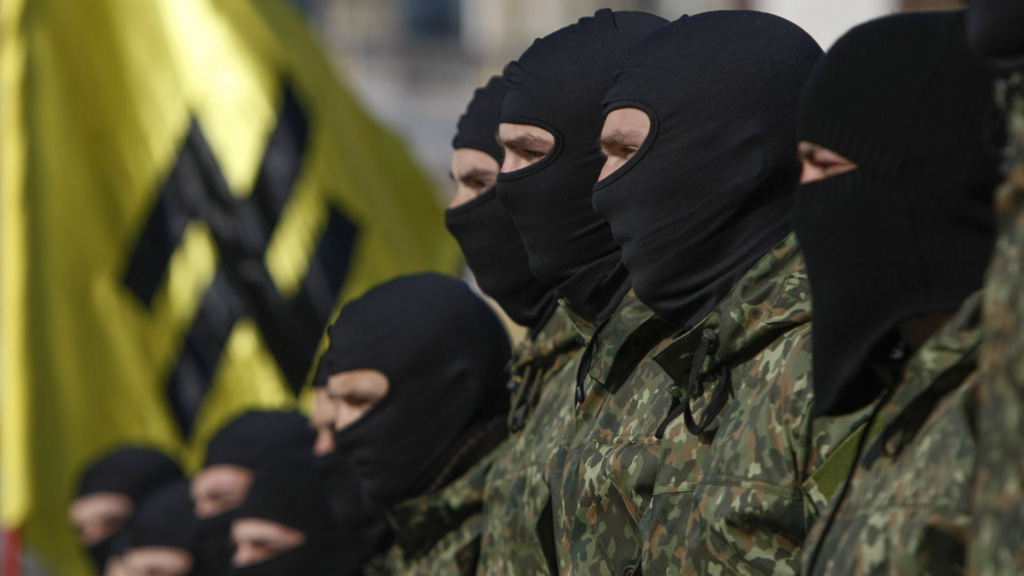
Individual members have professed to be neo-Nazis, and hardcore far-right ultra-nationalism is pervasive among members.
In January 2018, Azov rolled out its street patrol unit called National Druzhyna to “restore” order in the capital, Kyiv. Instead, the unit carried out pogroms against the Roma community and attacked members of the LGBTQ community.
“Ukraine is the world’s only nation to have a neo-Nazi formation in its armed forces”, a correspondent for the US-based magazine, the Nation, wrote in 2019.
Ukraine and the United States are the only two countries to vote against a Russian resolution on “combating the glorification of Nazism and neo-Nazism” at the United Nations. The EU and Canada were among 49 abstentions.
The 76th session of the UN General Assembly adopted a resolution on “combating glorification of Nazism, neo-Nazism and other practices that contribute to fuelling contemporary forms of racism, racial discrimination, xenophobia and related intolerance” in plenary meeting which took place on December 16, 2021.
Human rights violations and war crimes
A 2016 report by the United Nations Office of the High Commissioner for Human Rights (OCHA) has accused the Azov regiment of violating international humanitarian law.
The report detailed incidents over a period from November 2015-February 2016 where Azov had embedded their weapons and forces in used civilian buildings, and displaced residents after looting civilian properties. The report also accused the battalion of raping and torturing detainees in the Donbas region.
It’s telling that today throughout Ukraine Roma are being tied to a lamppost with their faces painted green.
Twitter is full of short videos showing people tied to a lamppost and publicly beaten. Some condescending commentator on Facebook assured me, “Bad things happen in wars”, I felt like giving him both barrels. I first entered a war zone at 19 years old. I was reminded of the quote “War is sweet to them that know it not” —Pindar. But then again, It was Facebook and the guy had probably played a few rounds of COD, obviously that made him an expert and an armchair warrior to boot.
The fact is, it’s blatant racism and just like the Russians, after this conflict, there will be a rocky road to justice for atrocities committed during this conflict, a legal reckoning. There will be a Kosovo type investigation, there will be people sitting in the Hague from both sides, some guilty, some scapegoats for the sake of appeasement. Of course, that will be one way of Zelensky removing his Nazi problem…
Whatever the story behind these disgusting pictures coming out of Ukraine of Roma girls strapped to posts and daubed with paint is – it’s surely very much worth noting that there is a uniformed member of the Ukrainian military standing by doing nothing to stop it happening… pic.twitter.com/kIZHFq96ZX
— The Prole Star (@TheProleStar) March 22, 2022
For now, nothing really goes down the memory hole.
We have seen nothing really goes down the memory hole, however, it’s becoming constantly harder to find the original posts, videos on youtube and articles that have not been changed to suit to present truth.
One thing is for sure, Ukraine is going through a terrible moment in its history, we can only hope that borders remain open and safe passage is found for those wanting to leave. We can only pray it remains a priority for both sides to keep civilians safe.
‘WAR IS EASY, PEACE IS HARD’
Russia has proposed a number of terms to impose on Ukraine in order to halt its “special military operation” in the country. Russia claims it would cease its military action in Ukraine if its conditions were met.
The conditions include:
- Ceasing all military action
- A change to the constitution to enshrine neutrality
- Acknowledgement of Crimea as Russian territory
- Recognition of Luhansk and Donetsk as independent
- Denazification
People have questioned how come this giant military machine that is Russia has not overrun Ukraine, why such a slow war. In my opinion, the objective has always been to try and reduce civilian casualties, occupy key areas and segregate the country’s major cities. while disrupting any attempts to create rallying points that could be used as focused attacks on the Donbas region.
If Russia was to commit to total war we would have seen bombing sorties in their thousands, city flattering artillery barrages, followed by infantry and motorised assaults. The lights would have gone off in Ukraine a long time ago, while supplies would have been stopped at the borders.
To the Russians this is not an all-out war this is an occupation while it consolidates the self-proclaimed People’s Republics of Donetsk and Luhansk.
During this time Donbas will undergo considerable border changes, the entire region will be reinforced, ensuring a clear distinct defensible border is created along its frontlines, and the bridges from Crimea are accessible into the breakaway regions.
Only then will Putin look at a negotiated peace agreement, this comes with conditions of Ukraine reverting back to its 2010 legislation of military neutrality as it was before the US 2014 coup.
The question about Ukraine’s Nazi problem has become redundant for the moment.

It’s understood you cannot undergo the task of denazification during the middle of a war, if anything both extremism and nationalism will only increase. If Putin gets peace on his terms, his demand for ‘denazification’ would be very difficult a task to undertake. Ukraine would need support from the international community. If Ukraine gets peace on their terms the danger will be extremism will spread like a disease across eastern Europe becoming a threat all in itself.
There’s no easy way to eradicate the virulent far-right extremism that has been poisoning Ukrainian politics, military and public life, but without vigorous efforts to counteract it, it may soon endanger adjoining countries like Hungry and Poland countries with their own far-right nationalist issue.
There is one winner in this war, the industrial arms complex, Nato budgets have been dramatically increased, Germany has literally committed to rearm. A budget this year alone of over £100 billion on its armed forces, where Biden just keeps signing those cheques.
In 2021 President Joe Biden signed into law a $777.7bn annual military budget, now it’s stated in 2022 another $773 billion is going to be available for the Department of Defence while other needs would go on top of that, potentially pushing a total above $800 billion.
Of course, Nato and the industrial arms complex it feeds would have won whichever way the Ukrainian conflict turned out.
All that is required is to create a threat, no matter whether it’s the War on terror or the old enemy Russia, once that threat is created and have manufactured consent from the public subscriptions are paid in 2% of their GDP.
President Dwight D. Eisenhower in his speech “The Chance for Peace”, also known as the Cross of Iron speech, shortly after the death of Soviet dictator Joseph Stalin, warned of the industrial arms complex.
Eisenhower evoked William Jennings Bryan in describing “humanity hanging from a cross of iron”. Although Eisenhower, a former military man, spoke against increased military spending, the Cold War deepened during his administration and political pressures for increased military spending mounted. By the time he left office in 1961, he felt it necessary to warn of the military-industrial complex in his final address.
Every gun that is made, every warship launched, every rocket fired signifies, in the final sense, a theft from those who hunger and are not fed, those who are cold and are not clothed. This world in arms is not spending money alone. It is spending the sweat of its laborers, the genius of its scientists, the hopes of its children. The cost of one modern heavy bomber is this: a modern brick school in more than 30 cities. It is two electric power plants, each serving a town of 60,000 population. It is two fine, fully equipped hospitals. It is some fifty miles of concrete pavement. We pay for a single fighter with a half-million bushels of wheat. We pay for a single destroyer with new homes that could have housed more than 8,000 people. . . . This is not a way of life at all, in any true sense. Under the cloud of threatening war, it is humanity hanging from a cross of iron.
-President Dwight D. Eisenhower on April 16, 1953
What’s clear is Biden and his vision of an NWO was always dependent on some form of conflict in Ukraine. Biden has been instrumental in pushing NATO expansionism as well as feeding extremism in Ukraine. He has a vision that entailed no consideration for the people, he has used Ukraine to bring about his forever war, a new cold war. No Ukrainian man, woman or child should be sacrificed to this US proxy war for geostrategic dominance of a new age of America.
A cold war that will see the militarisation of the world, an order that will compound no dissent. Anyone that speaks out of line will be shouted down, two minutes of hate will be mandatory, pointing fingers with accusations of, “are you with us, or against us”, or my favourite, “pick a side”. This is a new world order and it will bear no criticism, this is the world of Big brother, and in that world, we either confirm or become Winston Smith.
Ukrainian Nazis
Support Independent Journalism Today
Our unwavering dedication is to provide you with unbiased news, diverse perspectives, and insightful opinions. We're on a mission to ensure that those in positions of power are held accountable for their actions, but we can't do it alone. Labour Heartlands is primarily funded by me, Paul Knaggs, and by the generous contributions of readers like you. Your donations keep us going and help us uphold the principles of independent journalism. Join us in our quest for truth, transparency, and accountability – donate today and be a part of our mission!
Like everyone else, we're facing challenges, and we need your help to stay online and continue providing crucial journalism. Every contribution, no matter how small, goes a long way in helping us thrive. By becoming one of our donors, you become a vital part of our mission to uncover the truth and uphold the values of democracy.
While we maintain our independence from political affiliations, we stand united against corruption, injustice, and the erosion of free speech, truth, and democracy. We believe in the power of accurate information in a democracy, and we consider facts non-negotiable.
Your support, no matter the amount, can make a significant impact. Together, we can make a difference and continue our journey toward a more informed and just society.
Thank you for supporting Labour Heartlands
